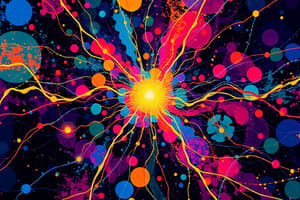Podcast
Questions and Answers
What occurs immediately after the action potential?
What occurs immediately after the action potential?
- Phase of hyperpolarization
- Threshold potential
- Refractory period (correct)
- Rapid depolarization
At what point does the graph indicate that depolarization starts?
At what point does the graph indicate that depolarization starts?
- Point A
- Point D
- Point B (correct)
- Point C
Which of the following differentiates the repolarization phase from hyperpolarization?
Which of the following differentiates the repolarization phase from hyperpolarization?
- Amount of ion exchange
- Duration of the phase
- Presence of threshold
- Direction of membrane potential (correct)
What does the dashed horizontal line in the graph represent?
What does the dashed horizontal line in the graph represent?
What characterizes the early stages of an action potential?
What characterizes the early stages of an action potential?
Flashcards
Depolarization
Depolarization
The initial phase of the action potential where the membrane potential becomes less negative, moving closer to zero.
Excitation Threshold
Excitation Threshold
The threshold level of membrane potential that must be reached for an action potential to occur. This level triggers the opening of voltage-gated sodium channels, allowing influx of sodium ions.
Repolarization
Repolarization
The phase where the membrane potential rapidly returns to its resting potential after depolarization.
Hyperpolarization
Hyperpolarization
Signup and view all the flashcards
Refractory Period
Refractory Period
Signup and view all the flashcards
Study Notes
Stages of Action Potential
- Action potential begins with a partial depolarization (e.g., from another neuron firing) [A].
- When the excitation threshold is reached, a sudden large depolarization occurs [B].
- This is rapidly followed by repolarization [C] and a brief hyperpolarization [D].
- A refractory period immediately follows, where no depolarization can occur [E].
- The graph shows the stages, with membrane potential (mV) on the vertical axis and time (msec) on the horizontal.
- The excitation threshold is shown in the graph.
Studying That Suits You
Use AI to generate personalized quizzes and flashcards to suit your learning preferences.




